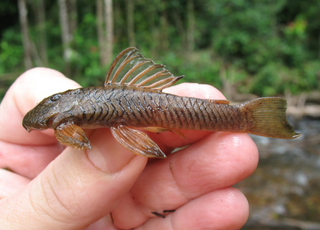
The Cetopsidae are a small family of catfishes, commonly called the whale catfishes.

The stream catfishes comprise the family Akysidae of catfishes.
Callichthys serralabium is a tropical freshwater fish belonging to the Callichthyinae sub-family of the family Callichthyidae.

Physopyxis is a genus of thorny catfishes native to tropical South America.

Auchenipterichthys is a genus of driftwood catfishes found in South America.

Helogenes is a genus of whale catfish found in tropical South America.

Paracetopsis is a genus of whale catfishes found in tropical South America.
Denticetopsis is a genus of catfishes of the family Cetopsidae.
Breitensteinia is a genus of catfishes of the family Akysidae. It includes three species.

Acrochordonichthys is a genus of catfishes of the family Akysidae. It includes ten species.
Pygidianops is a genus of pencil catfishes native to South America.

Cetopsis is a genus of catfishes of the family Cetopsidae.

Paraplotosus is a genus of catfishes native to Australasia and South-east Asia.

Entomocorus is a genus of catfishes of the family Auchenipteridae.

Auchenipterus is a genus of driftwood catfishes.
Denticetopsis praecox is a species of whale catfish endemic to Venezuela where it is known from the Baria River of the upper Rio Negro basin. This species grows to a length of 5.3 cm.
Denticetopsis royeroi is a species of whale catfish endemic to Venezuela where it is only known from the holotype collected in a tributary to the upper Rio Negro. This species grows to a length of 1.8 cm.
Deuterodon pelecus is a species of characid fish from Brazil. It can be distinguished from other species by: its body depth ; its short and pointed snout smaller than the orbital diameter; and a reduced number of branched anal fin rays. D. pelecus also differs from members of its genus by its characteristic color pattern. It possesses a single humeral spot that is constricted to the region above the lateral line; at the same time it shows a conspicuous midlateral body stripe from opercle to the caudal fin base, an autapomorphy of this precise species. Other Deuterodon species have a humeral spot that is vertically or horizontally elongate and have the midlateral stripe becoming faint near that humeral spot. The species name is derived from the Greek pelekus, meaning "axe", referring to the pigmentation shape resulting from the adjoinment of the humeral spot with the midlateral stripe.

Guyanancistrus nassauensis is a species of catfish belonging to the family Loricariidae, the suckermouth armored catfishes. It is discovered in 2005 and formally described in 2018. G. nassauensis is a rare species, highly endemic to the Nassau Mountains in Suriname, and is threatened with extinction by proposed or ongoing mining activities.

Cetopsis candiru, also known as candiru, candiru açú, candiru cobra or canero, is a carnivorous species of whale catfish found in the Amazon basin of Peru, Brazil and Bolivia. Similar to Cetopsis coecutiens, Cetopsis candiru is a large species of the genus Cetopsis and a widespread scavenger, known for its voracious feeding and the habit of burrowing into the carcasses of dead animals and humans. Despite its name, it is not closely related to the bloodsucking Candiru.










